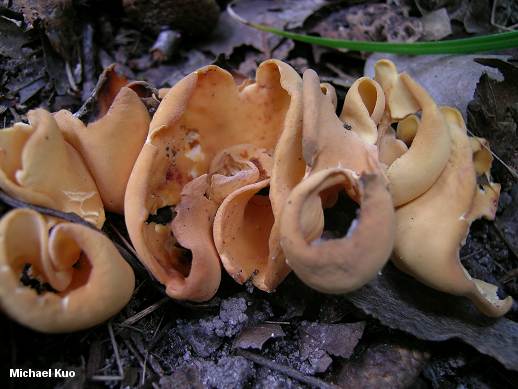en
names in breadcrumbs


Guidance for identification (German text)

A. aurantia is found throughout North America and a few other countries. It is very common, especially from summer to fall.
Aleuria aurantia is known as the orange peel fungus and is a cup fungi. This bright orange fungus has a brittle fruiting body consisting of several folds that look like several small cups, hence the name. A. aurantia is small, growing up to 4".The underside is felt-looking and white. A. aurantia is stalk-less and often grows in clusters as on dead wood.

The main use for A. aurantia is not directly for people. It thrives off of dead matter and is able to recycle nutrients back into the environment which helps animals, plants, and people.
A. aurantia is an edible mushroom, as it does not secrete any posionous toxins that would kill anyone who ate it. However, it is not often eaten due its close resemblance to Otidea onotica. Some species of Otidea are orange in color and produce very harmful human toxins.
Aleuria aurantia (orange peel fungus) is a widespread ascomycete fungus in the order Pezizales. The brilliant orange, cup-shaped ascocarps often resemble orange peels strewn on the ground,[1] giving this species its common name.
Christiaan Hendrik Persoon described the orange peel as Peziza aurantia in 1800. The specific epithet is the Latin word aurantia "orange". Karl Wilhelm Gottlieb Leopold Fuckel placed it the genus Aleuria in 1870.
The orange fruiting body is 2–10 cm wide, cup-shaped, often misshapen due to crowding from other fruiting bodies.[2] The spores are colorless[2] and scatter in visible clouds when disturbed.[1]
It is generally regarded as edible,[3] though difficult to collect intact[1] and not necessarily choice, with no particularly notable North American lookalikes.
In Europe, the orange peel may be confused with species of Otidea or Caloscypha which are poisonous or of unknown edibility.
Similar species include Caloscypha fulgens, Sarcoscypha coccinea, Sowerbyella rhenana, and members of Otidea and Peziza.[2]
The orange peel fungus grows on bare clay or disturbed soil throughout North America and Europe. It has also been found in the south of Chile. Aleuria aurantia fruits mainly in late summer and autumn.
Aleuria aurantia (orange peel fungus) is a widespread ascomycete fungus in the order Pezizales. The brilliant orange, cup-shaped ascocarps often resemble orange peels strewn on the ground, giving this species its common name.